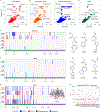Reimagining high-throughput profiling of reactive cysteines for cell-based screening of large electrophile libraries
- PMID: 33398154
- PMCID: PMC8316984
- DOI: 10.1038/s41587-020-00778-3
Reimagining high-throughput profiling of reactive cysteines for cell-based screening of large electrophile libraries
Abstract
Current methods used for measuring amino acid side-chain reactivity lack the throughput needed to screen large chemical libraries for interactions across the proteome. Here we redesigned the workflow for activity-based protein profiling of reactive cysteine residues by using a smaller desthiobiotin-based probe, sample multiplexing, reduced protein starting amounts and software to boost data acquisition in real time on the mass spectrometer. Our method, streamlined cysteine activity-based protein profiling (SLC-ABPP), achieved a 42-fold improvement in sample throughput, corresponding to profiling library members at a depth of >8,000 reactive cysteine sites at 18 min per compound. We applied it to identify proteome-wide targets of covalent inhibitors to mutant Kirsten rat sarcoma (KRAS)G12C and Bruton's tyrosine kinase (BTK). In addition, we created a resource of cysteine reactivity to 285 electrophiles in three human cell lines, which includes >20,000 cysteines from >6,000 proteins per line. The goal of proteome-wide profiling of cysteine reactivity across thousand-member libraries under several cellular contexts is now within reach.
Conflict of interest statement
Competing interests
B.F.C. is a founder and scientific advisor of Vividion Therapeutics. S.P.G. is a member of the scientific advisory boards of Thermo Fisher Scientific, Cell Signaling Technology and Casma Therapeutics. S.P.G. is a founder of Cedilla Therapeutics and a scientific advisor to Third Rock Ventures. All other authors declare no competing interests.
Figures






References
-
- Gehringer M & Laufer SA Emerging and re-emerging warheads for targeted covalent inhibitors: applications in medicinal chemistry and chemical biology. J. Med. Chem 62, 5673–5724 (2019). - PubMed
Publication types
MeSH terms
Substances
Grants and funding
LinkOut - more resources
Full Text Sources
Other Literature Sources
Miscellaneous

